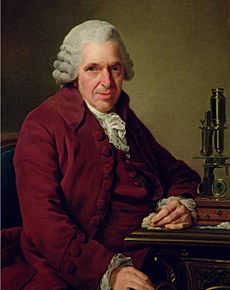Louis Jean-Marie Daubenton facts for kids
Quick facts for kids
Louis Jean-Marie Daubenton
|
|
|---|---|

Daubenton in 1791
|
|
| Born | 29 May 1716 Montbard, Côte-d'Or, France
|
| Died | 1 January 1800 (aged 83) |
| Scientific career | |
| Fields | naturalist |
Louis Jean-Marie Daubenton (born May 29, 1716, died January 1, 1800) was a famous French naturalist. A naturalist is someone who studies nature, including animals, plants, and minerals. He also helped write a very important book called the Encyclopédie. This book was a huge collection of knowledge about science, arts, and crafts.
Contents
Life and Work
Louis Jean-Marie Daubenton was born in Montbard, France. His father wanted him to study for the church. So, he sent Louis to Paris to study theology, which is the study of religion.
However, Louis was much more interested in medicine. When his father passed away in 1736, Louis was free to choose his own path. In 1741, he finished his medical studies in Reims. He then went back to his hometown, planning to work as a doctor.
Working with Buffon
Around this time, another famous person from Montbard, Georges-Louis Leclerc de Buffon, was writing a big book. It was about natural history and called Histoire naturelle, générale et particulière. In 1742, Buffon asked Daubenton to help him. Daubenton's job was to write detailed descriptions of animal bodies.
Even though they were very different, they worked well together. In 1744, Daubenton became a member of the French Academy of Sciences. Buffon also made him the keeper of the king's collection at the Jardin du Roi (King's Garden).
Contributions to Natural History
In the first part of the Histoire naturelle, Daubenton wrote about 182 different kinds of four-legged animals. He described their bodies and how they were put together. This work made him very well-known as an expert in comparative anatomy. Comparative anatomy is the study of how the bodies of different animals are similar and different.
Later, Buffon decided to remove Daubenton's detailed descriptions from the books. This was to make the books easier to read and sell more copies. But Daubenton kept working closely with Buffon at the Jardin du Roi.
Teaching and Research
Daubenton wrote many articles for the Parisian Royal Academy of Sciences. He shared his research on animals and the anatomy of both living and fossil animals. He also studied plant life, minerals, and farming.
One of his big successes was bringing merino sheep to France. These sheep are known for their very fine wool. In 1775, he was chosen to be a member of the American Philosophical Society.
From 1775, Daubenton taught natural history at the College of Medicine. In 1783, he taught about farming at the Alfort school. He was also a professor of mineralogy at the Jardin du Roi. People really liked his lectures, and he was popular until the end of his life.
In December 1799, he became a member of the senate. But at his first meeting, he had a sudden illness and passed away shortly after in Paris.
Animals Named After Daubenton
Daubenton's name is remembered in the names of several animals. One is the unique lemur called the aye-aye (Daubentonia madagascariensis). There is also a bat in Europe called Daubenton's bat (Myotis daubentoni). You can also find a type of kale called Daubentons Kale.
See also
 In Spanish: Louis Jean Marie Daubenton para niños
In Spanish: Louis Jean Marie Daubenton para niños
- Society of the Friends of Truth


